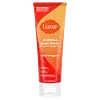What's inside
What's inside
 Key Ingredients
Key Ingredients

No key ingredients
 Benefits
Benefits

 Concerns
Concerns

 Ingredients Side-by-side
Ingredients Side-by-side

Water
Skin ConditioningCocamidopropyl Hydroxysultaine
CleansingSodium Methyl 2-Sulfolaurate
CleansingDisodium 2-Sulfolaurate
CleansingParfum
MaskingGlycerin
HumectantCaprylyl Glycol
EmollientGlyceryl Oleate
EmollientCoco-Glucoside
CleansingEthylhexylglycerin
Skin ConditioningPhenethyl Alcohol
MaskingAloe Barbadensis Leaf Juice Powder
Skin ConditioningCitric Acid
BufferingMandelic Acid
AntimicrobialCucumis Sativus Fruit Extract
EmollientCalendula Officinalis Flower Extract
MaskingPalmaria Palmata Extract
Skin ProtectingBambusa Vulgaris Shoot Extract
AntioxidantWater, Cocamidopropyl Hydroxysultaine, Sodium Methyl 2-Sulfolaurate, Disodium 2-Sulfolaurate, Parfum, Glycerin, Caprylyl Glycol, Glyceryl Oleate, Coco-Glucoside, Ethylhexylglycerin, Phenethyl Alcohol, Aloe Barbadensis Leaf Juice Powder, Citric Acid, Mandelic Acid, Cucumis Sativus Fruit Extract, Calendula Officinalis Flower Extract, Palmaria Palmata Extract, Bambusa Vulgaris Shoot Extract
Water
Skin ConditioningAloe Barbadensis Leaf Juice
Skin ConditioningCocamidopropyl Hydroxysultaine
CleansingSodium Laurylglucosides Hydroxypropylsulfonate
CleansingDisodium Cocoyl Glutamate
CleansingSodium Chloride
MaskingSodium Cocoyl Isethionate
CleansingCalendula Officinalis Flower Extract
MaskingChamomilla Recutita Flower Extract
MaskingCocos Nucifera Fruit Extract
EmollientGlycerin
HumectantCaprylyl Glycol
EmollientPanthenol
Skin ConditioningGuar Hydroxypropyltrimonium Chloride
Skin ConditioningCaprylhydroxamic Acid
Trisodium Ethylenediamine Disuccinate
Sodium Benzoate
MaskingSodium PCA
HumectantCoconut Acid
CleansingGlutamic Acid
HumectantCitric Acid
BufferingWater, Aloe Barbadensis Leaf Juice, Cocamidopropyl Hydroxysultaine, Sodium Laurylglucosides Hydroxypropylsulfonate, Disodium Cocoyl Glutamate, Sodium Chloride, Sodium Cocoyl Isethionate, Calendula Officinalis Flower Extract, Chamomilla Recutita Flower Extract, Cocos Nucifera Fruit Extract, Glycerin, Caprylyl Glycol, Panthenol, Guar Hydroxypropyltrimonium Chloride, Caprylhydroxamic Acid, Trisodium Ethylenediamine Disuccinate, Sodium Benzoate, Sodium PCA, Coconut Acid, Glutamic Acid, Citric Acid
Ingredients Explained
These ingredients are found in both products.
Ingredients higher up in an ingredient list are typically present in a larger amount.
Calendula Officinalis Flower Extract comes from the common Marigold plant. This ingredient is a skin conditioner.
Marigolds contain flavonoids. Flavonoids are a group of substances found naturally in plants. They possess antioxidant and inflammation properties.
This ingredient soothes skin inflammation by inhibiting inhibiting a part of the inflammation process.
Marigolds have been used in traditional medicine throughout Asia and Europe.
Learn more about Calendula Officinalis Flower ExtractCaprylyl Glycol is a humectant and emollient, meaning it attracts and preserves moisture.
It is a common ingredient in many products, especially those designed to hydrate skin. The primary benefits are retaining moisture, skin softening, and promoting a healthy skin barrier.
Though Caprylyl Glycol is an alcohol derived from fatty acids, it is not the kind that can dry out skin.
This ingredient is also used as a preservative to extend the life of products. It has slight antimicrobial properties.
Learn more about Caprylyl GlycolCitric Acid is an alpha hydroxy acid (AHA) naturally found in citrus fruits like oranges, lemons, and limes.
Like other AHAs, citric acid can exfoliate skin by breaking down the bonds that hold dead skin cells together. This helps reveal smoother and brighter skin underneath.
However, this exfoliating effect only happens at high concentrations (20%) which can be hard to find in cosmetic products.
Due to this, citric acid is usually included in small amounts as a pH adjuster. This helps keep products slightly more acidic and compatible with skin's natural pH.
In skincare formulas, citric acid can:
While it can provide some skin benefits, research shows lactic acid and glycolic acid are generally more effective and less irritating exfoliants.
Most citric acid used in skincare today is made by fermenting sugars (usually from molasses). This synthetic version is identical to the natural citrus form but easier to stabilize and use in formulations.
Read more about some other popular AHA's here:
Learn more about Citric AcidCocamidopropyl Hydroxysultaine is a synthetic cleansing agent, though it is derived from coconut oil.
It is used to enhance the texture of products by boosting lather and thickening the texture. As a cleanser, Cocamidopropyl Hydroxysultaine is mild.
Glycerin is already naturally found in your skin. It helps moisturize and protect your skin.
A study from 2016 found glycerin to be more effective as a humectant than AHAs and hyaluronic acid.
As a humectant, it helps the skin stay hydrated by pulling moisture to your skin. The low molecular weight of glycerin allows it to pull moisture into the deeper layers of your skin.
Hydrated skin improves your skin barrier; Your skin barrier helps protect against irritants and bacteria.
Glycerin has also been found to have antimicrobial and antiviral properties. Due to these properties, glycerin is often used in wound and burn treatments.
In cosmetics, glycerin is usually derived from plants such as soybean or palm. However, it can also be sourced from animals, such as tallow or animal fat.
This ingredient is organic, colorless, odorless, and non-toxic.
Glycerin is the name for this ingredient in American English. British English uses Glycerol/Glycerine.
Learn more about GlycerinWater. It's the most common cosmetic ingredient of all. You'll usually see it at the top of ingredient lists, meaning that it makes up the largest part of the product.
So why is it so popular? Water most often acts as a solvent - this means that it helps dissolve other ingredients into the formulation.
You'll also recognize water as that liquid we all need to stay alive. If you see this, drink a glass of water. Stay hydrated!
Learn more about Water